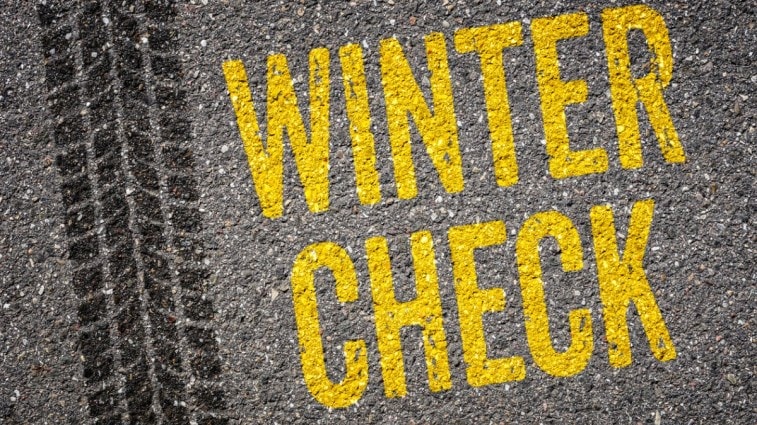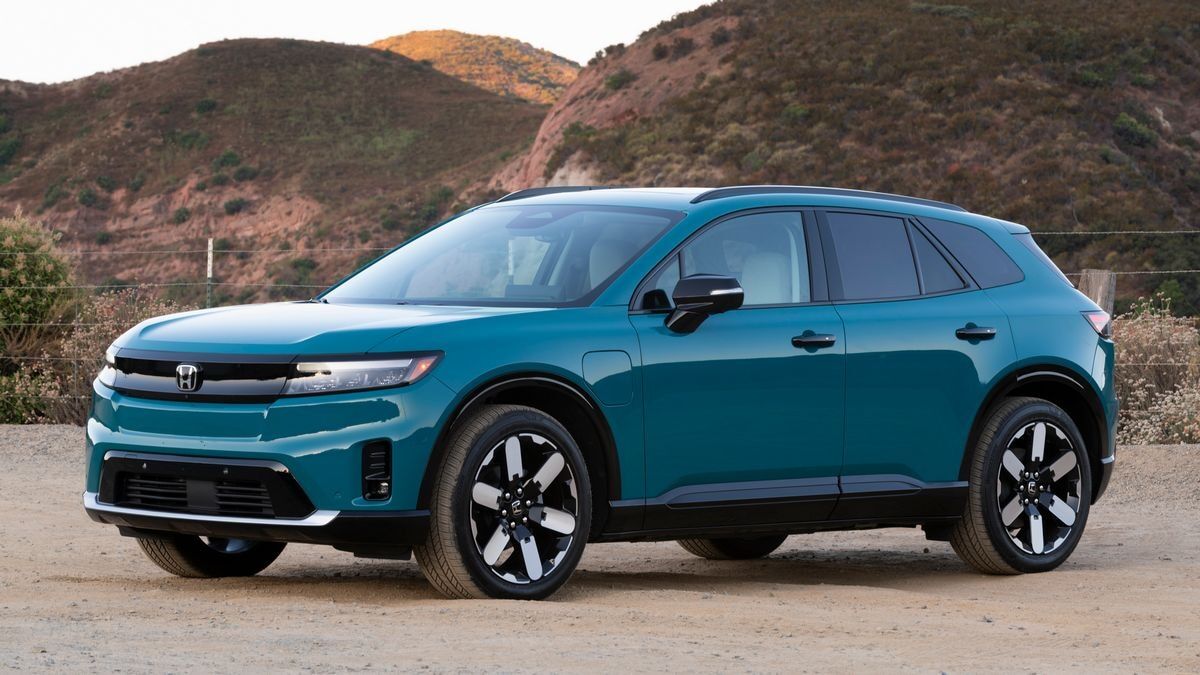
Quick Tips About Driving in Winter Weather
- Replace all-season tires with winter tires for improved traction control, braking, and overall performance in cold conditions.
- Prepare an emergency kit, including an ice scraper, gloves, blankets, and nonperishable snacks.
- Learn how to recognize and safely navigate icy roads.
- Maintain vehicle fluid and fuel levels and know how cold weather affects your car’s battery.
If you live in a region with harsh cold and heavy snowfall in the winter, it’s essential to prepare your car for the season. Snowy weather conditions can bring new hazards and challenges to your usual route. The right tires, proper driving techniques, vehicle upkeep, supplies, and storage considerations can mean the difference between a car that goes the distance and one that always needs service. This snow survival guide for drivers explains various ways to prepare your car for winter.
- Switch to Winter Tires
- Pack a Winter Car Kit
- Driving in Snow
- Winter Car Care Tips
- Parking and Storing Your Car in the Winter
Switch to Winter Tires
Winter tires help keep you steady on the road in multiple ways. They offer better traction control, shorten your braking distance, help you turn more smoothly, and more. Additionally, the materials used in winter tires stay more flexible in cold temperatures, helping ensure you keep in contact with the road.
According to Goodyear, the best time to swap your all-season tires with snow tires is in November — “from Thanksgiving to Tax Day.” However, it mostly depends on the conditions in your geographic location. Winter tires are designed for temperatures below 45 degrees Fahrenheit. Select the appropriate size and load rating for your vehicle and stay on top of regular maintenance and inspections for peak performance throughout the season.
Tire Tips for Winter
While all-season tires can be driven in snowy road conditions, snow tires are highly recommended for improved handling, braking, and traction control for drivers in regions where the temperature is consistently cold. Those in areas that have an occasional cold snap during milder winters can keep all-season rubber on their car year-round.
Regardless of the tire type, it is crucial for drivers to monitor the air pressure and keep tires inflated to recommended levels. Cold weather lowers tire pressure by one pound per square inch (PSI) for every 10-degree temperature drop, which affects how the car grips and handles on the road. Check pressure regularly to maintain top performance and help stay safe when driving. Newer vehicles have tire pressure monitoring systems (TPMS) that alert drivers when inflation is needed.
If you’re traveling to or across mountains, invest in a set of tire chains. Some areas require vehicles to have chains when winter conditions deteriorate.
MORE: Types of Gasoline Explained: Learn the Differences
Pack a Winter Car Kit
A well-stocked cold-weather car kit can make emergency situations less stressful. Keep your supplies organized and easily accessible in your vehicle in case of a severe weather event that leaves you stranded. Everyone will have different needs, but consider including items like these:
- Antifreeze – Keep your fluid levels full to help regulate your car’s temperature.
- Blankets – Keeping warm is essential if your car’s heating system fails.
- Duct tape – This can help patch and temporarily repair various issues.
- Extra clothes – If you have to leave your vehicle, a change of clothes and sturdy boots may come in handy.
- First-aid supplies – Don’t forget bandages, gauze, skin ointments, etc.
- Flashlights, LED road flares – Snow flurries can obstruct your view as well as that of other drivers, even if it’s light outside. A flashlight is especially helpful for making roadside repairs in the dark. Don’t forget the extra batteries.
- Gloves – Protect your hands from the elements when you’re stranded.
- Ice scraper – Use this to clear the windshield and windows of snow and ice.
- Microfiber cloths – Have cloths or absorbent towels for cleanup as needed.
- Portable phone charger – Always have a way to power up your mobile device in case you need to call for help.
- Shovel – Use a small shovel to clear a path and help dig out of mushy ditches.
- Snacks – Have small food items stocked to keep hunger at bay while waiting for help.
- Snow brush – Make sure your view of the road is unobstructed, and remove snow from the car hood, roof, and trunk lid.
- Tire pressure gauge – Check your levels often because cold weather can adversely affect your tire pressure.
- Tool kit – Packing a basic tool kit ensures you can always change a bolt or troubleshoot when needed.
- Water – Have bottled water on hand for drinking and other purposes in and around the vehicle.
For severe weather, consider adding:
- Fire extinguisher
- Portable jump starter/air compressor unit
- Sand or kitty litter for traction
- Snow chains or other traction devices
Driving in Snow
You must have a clear understanding of how to handle your vehicle in times of extreme winter weather. Snow and ice bring unique challenges for all drivers, no matter the level of experience. Here are some tips for a safe winter driving experience:
- Learn how to recognize black ice. If the pavement looks wet as you approach, even though the rest of the area is seemingly dry, it may be a patch of black ice. Always reduce your speed and avoid ice patches as you’re able. If needed, come to a complete stop while you wait for other cars to pass.
- Pay attention to the temperature. Many vehicles show the outside temperature on the dashboard panel or infotainment system. When the gauge is near or below freezing, drive with extreme caution.
- Properly use headlights and fog lights. Visibility is crucial when the snow starts to fall. Brighter lights will help you see more clearly when it’s dark outside.
- Maintain control. Understand your vehicle’s traction control modes and learn how to regain control in skid situations. Have an emergency response plan in case you get stuck in the snow.
- Consider enrolling in a winter driving course. Instruction and training can help sharpen your skills on the road and boost your confidence in challenging weather conditions.
Most vehicles were made to handle snowy weather conditions. However, it’s important to evaluate your level of confidence on the road when it snows. Safety first. If you’re uncertain behind the wheel with flurries ahead, plan for short trips only until you’ve gained more experience.
MORE: Car Maintenance Guide: Everything You Need to Know
Winter Car Care Tips
Take steps to winterize your vehicle if you live in regions that experience extreme cold. Each car will have its own set of requirements for cold weather prep, but here are some essentials:
- Battery: Learn how cold weather impacts your battery, especially if you drive an electric vehicle (EV). For gas-powered vehicles, test your battery before the temperatures begin to drop and replace old batteries as needed.
- Fluids: Regularly check and top off antifreeze, coolant, transmission fluid, and engine oil levels. Use de-icing winter windshield washer fluid.
- Brakes: Your brakes should be quick and responsive in snowy weather. Have them inspected to ensure they’re in good working order. Check your brake fluid levels.
- Heating and cooling: A working heating and defrosting system is essential for comfort and visibility during winter driving.
- Fuel: Keep your gas tank at least half full or plan your electric car charging schedule ahead of time. For gas vehicles, maintain your tank levels to help prevent the fuel lines from freezing. This will also ensure you have enough fuel to heat the cabin in an emergency.
Warming your car for a few minutes can help make your commute smoother and more comfortable. Electric vehicles benefit from having the car warm while still connected to a charger before you start driving, which can help extend the range of your trip by not using battery energy for the cabin’s heating system.
TIP: Download a PDF of this guide to have on hand and share with others.
Parking and Storing Your Car in the Winter
We recommend using a covered garage or parking structure if you store your car for an extended period during the winter to protect the exterior from snow and ice buildup. Have a full-service tuneup to detect and address significant issues and take steps to winterize the vehicle before leaving it during the cold season.
Start and drive your stored vehicle periodically during the season to prevent issues like flat spots on tires and to maintain the health of the engine and battery. If you’re leaving your car behind for the winter, have a trusted friend or family member take it for short trips as needed. Depending on how long you’re away, consider servicing the vehicle again when you return.
Editor’s Note: This article has been updated since its initial publication.







